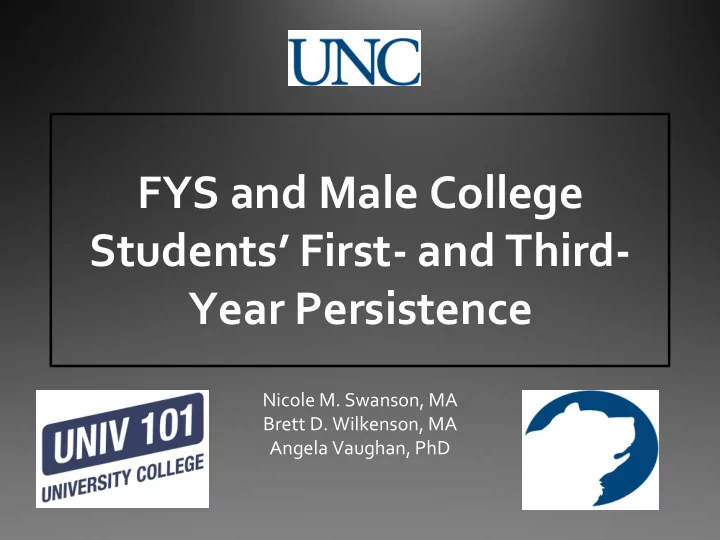

FYS and Male College Students’ First - and Third- Year Persistence Nicole M. Swanson, MA Brett D. Wilkenson, MA Angela Vaughan, PhD
The Gender Gap Males have lower rates of college enrollment 66.5% of males go directly to college, 70.4% of females (National Center for Education Statistics, 2009) Males have lower rates of college graduation 6 year graduation rates: Males= 56%, Females 61% (National Center for Education Statistics, 2014) In 2007 , Amongst 25-29 year olds, 25.3% of males and 31.6% of females held bachelors degrees (Mortenson, 2007) Males have higher rates of academic and social difficulties Lower grades, fewer credits, higher rates of academic probation and social suspensions. (Courtenay, 2004; Conger & Long, 2008)
2015: Males= 42.3%, Females= 57.7% Source: National Center for Education Statistics’ “The Condition of Education 2011”
Source: Digest of Education Statistics 2011
University 101 3 credit, Full semester course Coordinated Curriculum Small class size Challenging and Rigorous Interactive Environment Instructors *This program was selected Highly competitive by the Colorado Department Proactive of Higher Education for recognition in the Colorado High Expectations Completes program* Approachable
Looking at Male Persistence and UNIV 101
Method of Analysis ANCOVA DVs= Persistence , Fall term GPA, Fall 2014 Cumulative GPA IV = University 101 Covariate= INDEX
2013 Males University 101 Non-University 101 Total Participants 378 1529 Total Male Students 126 557 Non-White Males 62 200 First-Generation 68 263 Males
All 2013 Male Students Persistence to Fall 2014 P-value = 0.019 Non-UNIV 101= 63% UNIV 101 = 80% Fall 2013 GPA P-value = 0.009 Non-UNIV 101 = 2.33 UNIV 101 = 2.61
2013 First Generation Males Persistence to Fall 2014 P-value = 0.001 Non-UNIV 101= 62 % UNIV 101 = 84% Fall 2013 GPA Non-UNIV 101 = 2.12 P-value = 0.011 UNIV 101 = 2.52
2013 Non-White Males Persistence to Fall 2014* P-value < 0.0001 Non-UNIV 101= 59% UNIV 101 = 84% Fall 2013 GPA Non-UNIV 101 = 1.99 P-value = 0.006 UNIV 101 = 2.48 * INDEX was not significant. When it was removed from the analysis the outcome did not change.
2011 Males University 101 Non-University 101 Total Participants 387 1824 Total Male Students 120 708 Non-White Males 39 216 First-Generation 44 299 Males
All 2011 Male Students Persistence to Fall 2014 Non-UNIV 101= 40% P-value < 0.0001 UNIV 101 = 64% Fall 2011 GPA Non-UNIV 101 = 2.14 P-value < 0.0001 UNIV 101 = 2.62 Fall 2014 Cumulative GPA Non-UNIV 101 = 2.90 P-value = 0.729 UNIV 101= 2.84
2011 First Generation Males Persistence to Fall 2014 Non-UNIV 101= 37% P-value = 0.001 UNIV 101 =64% Fall 2011 GPA Non-UNIV 101 = 2.01 UNIV 101 = 2.67 P-value < 0.001 Fall 2014 Cumulative GPA Non-UNIV 101 = 2.88 P-value = 0.808 UNIV 101= 2.89
Non-White Males Persistence to Fall 2014* Non-UNIV 101= 38 % P-value < 0.001 UNIV 101 =72 % Fall 2011 GPA Non-UNIV 101 = 1.95 UNIV 101 = 2.62 P-value < 0.001 Fall 2014 Cumulative GPA Non-UNIV 101 = 2.82 P-value = 0.890 UNIV 101= 2.82 * INDEX was not significant. When it was removed from the analysis the outcome did not change.
Factors Contributing to Student Persistence of persistence (Normyle, 2011) Focus on early intervention Most attrition happens before the second year (Adelman, 2006) Engaged, committed, and Preparation and tools for organized instructors success Instructor behavior and practices Early habit development and are important factors in student exposure to college success skills persistence, especially in the first important for persistence (Adelman, year (Pascarella, Salisbury,& Blaich, 2011) 2006) Institutional commitment (Davidson, Building peer support Beck, & Milligan, 2009; Normyle, 2011) Meaningful interactions with other students is a significant indicator
Discussion
References Adelman, C. (2006). The toolbox revisited: Paths to degree completion from high school through college. Washington, D.C.: U.S. Department of Education. Conger, D., & Long, M. C. (2010). Why are men falling behind? Explanations for the gender gap in college outcomes. Annals of the American Academy of Political and Social Science, 627(1), 184-214. Courtenay, W.H. (2004). Best practices for improving men’s health. In G.E. Kellom (Ed.) Developing effective programs and services for college men. (pp. 59-74). San Francisoco: Jossey-Bass. Davidson, W. B., Beck, H. P., & Milligan, M. (2009). The College Persistence Questionnaire: Development and validation of an instrument that predicts student attrition. Journal of College Student Development, 50(4), 373-390. Horn, L. Berger R. (2004). College persistence on the rise? Changes in 5-year degree completion and postsecondary persistence rates between 1994 and 2000. (NCES 2005- 156). Retrieved nces.edu.gov/pubs2005/2005156.pdf.
References cont. Mortenson, T.G. (2007). College continuation rates for recent high school graduates 1959- 2006. Postsecondary Education Opportunity, 198. Normyle, M. K. (2011). Male college students and success: A study of the early predictors of first-year academic performance, progression, and persistence of male undergraduate students. (Order No. 3484442, University of Virginia). ProQuest Dissertations and Theses,1 85. Pascarella, E. T., Salisbury, M. H., & Blaich, C. (2011). Exposure to effective instruction and college student persistence: A multi-institutional replication and extension. Journal of College Student Development, 52(1), 4-19. U.S. Department of Education, National Center for Education Statistics. (2014). The Condition of Education 2014 (NCES 2014-083)
Contact Info: Dr. Angela Vaughan 970-351-1175 Angela.Vaughan@unco.edu
Recommend
More recommend